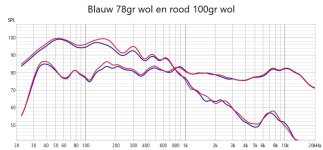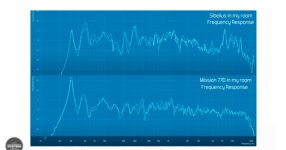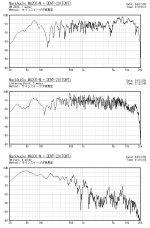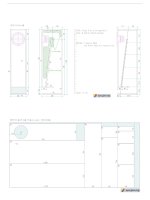Running the Sibelius here about 4 months now and still going good with all sorts music and sound levels. At higher SPLs within the listening room will become a bit too uncomfortable to listen though still clean sounding … perhaps in other settings maybe
Or perhaps some people have different requirements to your own, and they don't need anybody else to tell them what to like?
Well, that depends what you mean by 'give up the ghost'. If you read my post again, you'll see I wrote:I beg to differ a little ... ( but it does depend on music type )
With certain kinds of music & SPL, these little speakers WILL 'give up the ghost'.
a/ Xmax is a [not especially meaningful] figure for linear distortion, not the limit of mechanical travel, and b/ the drivers have built in arrestors that indicate when you've reached rated Xmax.
There is more travel available beyond Xmax until Xmech [mechanical limit] is reached. Since Xmax doesn't actually mean very much in itself, it's not a lightswitch between 'good / bad' (especially with overhung motors), nor does it necessarily mean the speaker will unload once it's reached -that depends on the design. All other things being equal, as I also said, a small speaker will be more limited in LF dynamic range than a larger one, but not everybody wants or needs that, and most people are aware of that rather basic fact.
People will buy what they like. I doubt many Sibelius buyers are very interested in, say, a large JBL 3-way standmount.Just think about what else you could get for your money (!?!)
Really? Always? Positioned where, crossed where and how, and are these criteria universally applicable? Speaking as somebody who designs both single driver and multiway speakers for DIY and for individual / commercial clients, I haven't found any panaceas myself, but if you have, good for you.PS.
Super tweeter ALLWAYS.
OK >Or perhaps some people have different requirements to your own, and they don't need anybody else to tell them what to like?
I am just trying to be Objective & Scientific > But you are also correct. This is a PRIME example of Yin & Yang.
A word of advice: don't let anybody (anybody -& I'm speaking generally here, not necessarily about this thread, or anything on the forum at all for that matter) tell you what you 'should' or 'shouldn't' like. As far as audio goes, there can often be a difference between preference and what is theoretically 'accurate', and which route you take depends on what your goals are.I am confused now.
https://en.wikipedia.org/wiki/Distortion#Harmonic_distortionWhat is harmoni distorsion?
Yes & no. As far as audio systems are concerned, technically distortion is distortion: it's something added to the original signal by the equipement. So from a black / white perspective of 'high fidelity' or 'as close to the original signal as possible', it's not ideal. In practice, as usual, it's not quite so simple. There are different types of distortion, HD being one, and there are different orders of HD -2nd, 3rd, 4th & so on. They're sometimes lumped into a total (Total Harmonic Distortion / THD) which is a fairly useless metric because the individual orders can (can 😉 ) produce different effects, and if you've only got a lumped total you don't actually know what's going on. It can also depend on the levels of individual harmonic distortion orders relative to the level of the original input signal. If it's low enough not to be audible, then QED: it's not audible. The individual levels also vary with frequency, rather than staying static.Is that bad?
Generalising: 2nd order HD is often thought to be less of an issue than higher orders -which is probably true to a certain extent, but also a chronic simplification, since none of this really exists in isolation. Some people do prefer the sound of a bit of extra HD of different types anyway -it's not 'accurate', but they like it. Nelson [Pass] often plays around with this with his Zen, First Watt etc. amplifiers, as do many others; in speakers we often see some similar / equivalent features. For e.g. 20 years or so ago, Vifa / Scan Speak introduced a trend for tweeters with wide roll surrounds that form an active part of the radiating area: this brought a few different characteristics into play, but one was an elevated HD2 (2nd order harmonic distortion) relative to the others, especially toward the lower end of its range. Reverting to amplifiers, most (not all, but most) SET amps for e.g. tend to have a dominant 2nd order characteristic to their HD performance, giving a subjectively (I hate the term, but it'll do) softer presentation. Again, that's over simplistic & there are other reasons too, but you get the general idea. 3rd order by contrast can do the opposite, apparently putting a bit more subjective 'edge' into the presentation (same caveats apply).
And just to chuck a ruddy great spanner in the works of all that, Floyd Toole & other researchers have pointed out the audibility of HD itself under many practical conditions is less than commonly believed. YMMV as always.
Last edited:
This is because a driver measures very different in a cabinet compared to without a box or in an infinite baffle. The measurement result will differ more than 10 dB at some frequencies.
The cabinet will give you difractions, bumbs and dips and baffle step losses, - all depending on the specific geometry of the loudspeaker box.
Understanding this, one realizes that frequency measurements are wortheless from the driver manufacturer because in the real world you always put the driver in a cabinet.
Markaudio has 100 dB on the measurement scale. The standard measurements procedure at stereophile for loudspeakers is 50 dB . You have 70 dB on your measurements. The graphs will look very different only because of that.
The cabinet will give you difractions, bumbs and dips and baffle step losses, - all depending on the specific geometry of the loudspeaker box.
Understanding this, one realizes that frequency measurements are wortheless from the driver manufacturer because in the real world you always put the driver in a cabinet.
Markaudio has 100 dB on the measurement scale. The standard measurements procedure at stereophile for loudspeakers is 50 dB . You have 70 dB on your measurements. The graphs will look very different only because of that.
Last edited:
For optimal stereosystem compensation with two loudspeakers, each speaker need a small peak between 900-1,7 kHz ( +1,5 dB ) and a broad dip at 3,5 kHz ( - 3 dB ) followed by a small peak at 6,5 kHz ( +1 dB ). This will be optimal psychoacoustic for stereo listening with the speakers placed at 1:1:1,18 distance.
This will make the speakers completely dissapear in the soundstage and it will sound very ”real ” and 3D holografic.
Its interesting that markaudio seems to use a bigger dip at 3,5 kHz and the cabinet of the Sibelius makes a + 2,5 dB ”bump” centered at 850 Hz . Pretty near optimal curve, ( a bit to much ) and much better than all the Harman speakers out there with flat frequency response and perfect directivity, sounding more like two mono boxes and not the real event…
This will make the speakers completely dissapear in the soundstage and it will sound very ”real ” and 3D holografic.
Its interesting that markaudio seems to use a bigger dip at 3,5 kHz and the cabinet of the Sibelius makes a + 2,5 dB ”bump” centered at 850 Hz . Pretty near optimal curve, ( a bit to much ) and much better than all the Harman speakers out there with flat frequency response and perfect directivity, sounding more like two mono boxes and not the real event…
Last edited:
nd what is theoretically 'accurate'
which given all the ways things are important, we still cannot measure everything required o determine if a speaker system (system incluides amp and whatever connects them) is accurate. We have some indicators, but they are insufficient. So at some point we have to trust our ears
To quote Floyd Toole:
Two ears and a brain are massively more analytical and adaptable than an omnidirectional microphone and an analyzer.
dave
technically distortion is distortion: it's something added to the original signal by the equipement.
Distortion is anything different from the originating sound waves. It is both stuff added, and probably more importatly, things that are subtracted (the latter is all too poften ignored).
One has to keep in mind that for some, added stuff can be lived with if the system does not lose the small stuff often lost during recording, transmission, adn replay.
dave
Measurements from an actual Sebelius by a reviewer “Pursuit Perfect System”. Thoughts?I don’t know why I measure at 1 meter from the driver in the Sibelius clone cabinet a dip at about 4K while the frequency response graph on the Alpair datasheet does not have this.View attachment 1391261
Attachments
Baffle step ” bump” at 1 kHz ( the cause is the box shape ) and the inbuilt dip at 3,5 kHz caused by the driver . Psycoacoustical correct to sound good with two stereo speakers.
The mission 770 has this 1 kHz bump to, but to lesser degree. Its because of the box shape. A flat response in this area makes the speakers sound boring with two speakers and very much sounding like two boxes and not the real event.
As I wrote earlier, the Sibelius is much more ” right” than any Harman corrected speaker when used with stereo listening, but the bumps and dips in the Sibelius might be a little to much ( can be corrected with dsp - see the post 1070 and 1093 )
………
Edit : the measurements done by Pursuit perfect system seems do be done by an amateur , no gating used meaning one can not trust anything below 300 Hz . Maybe he also used two speakers at the same time measuring from listening position , this will give comb filtering issues making a false result from 300-20000 Hz. The measurement is probably wortheless.
The correct way to measure a speaker is much more like this , 1 meter from only one speaker. ( ignore result below 200 Hz ).
The sloping frequency curve is only the bass port.

The mission 770 has this 1 kHz bump to, but to lesser degree. Its because of the box shape. A flat response in this area makes the speakers sound boring with two speakers and very much sounding like two boxes and not the real event.
As I wrote earlier, the Sibelius is much more ” right” than any Harman corrected speaker when used with stereo listening, but the bumps and dips in the Sibelius might be a little to much ( can be corrected with dsp - see the post 1070 and 1093 )
………
Edit : the measurements done by Pursuit perfect system seems do be done by an amateur , no gating used meaning one can not trust anything below 300 Hz . Maybe he also used two speakers at the same time measuring from listening position , this will give comb filtering issues making a false result from 300-20000 Hz. The measurement is probably wortheless.
The correct way to measure a speaker is much more like this , 1 meter from only one speaker. ( ignore result below 200 Hz ).
The sloping frequency curve is only the bass port.
Last edited:
Quite consistent to both the driver & other clone measurements as far as trending goes -it appears mostly a matter of difference in scaling / smoothing / window applied, and potentially some mic. positioning differences -a few mm difference in alignment can make quite a difference.Measurements from an actual Sebelius by a reviewer “Pursuit Perfect System”. Thoughts?
With my generalising hat on, as far as measurements are concerned, when it comes to smaller or single driver speakers, I tend to follow Jeff Bagby's preference for a mic. distance between 3x - 5x the effective radiating diameter of the driver, providing this also provides a distance at least double the effective baffle width -if not, it needs to be kicked up to that to correctly show diffraction. Levels can be normalised to the 1m/2.83v standard after that if desired, although that's not really necessary unless you want to show that SPL value. Vent output needs to be taken using the normal nearfield techniques of course, normalised to the direct driver SPL & spliced or preferably blended into the driver output for a reasonable average.
for this box?Another interesting measurement for the MA200 by @nandappe, just highlighting the techniques used
Attachments
- Home
- Loudspeakers
- Full Range
- Pearl Acoustic Sibelius




